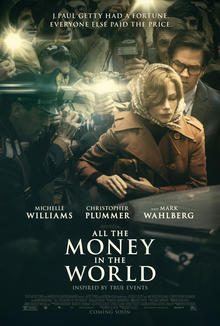by Peter J. O’Connell
The Commuter. Released
Jan. 2018. Runtime: 105 mins. MPAA Rating: PG-13 for some intense
action/violence and for language.
Lately, train rides in movies
have been getting as dangerous as stagecoach rides through Indian country used
to be in movies back in the day. In 2016 Emily Blunt’s character in The Girl on the Train becomes drawn into
a mystery involving adultery, a disappearance, and murder, based on something
she sees while riding the train. In 2017 Hercule Poirot (Kenneth Branagh) and
his mustache become involved in attempting to solve the eponymous crime on the
eponymous mode of transportation in Murder
on the Orient Express. Now in The
Commuter, Liam Neeson, Hollywood’s favorite senior citizen action hero, is
sucked into a murderous conspiracy that turns a usually placid choo-choo ride
into an hour-and-a-half life and death struggle.
Neeson is Mike MacCauley, a
former top profiler for the NYPD, who has been working for ten years as an
insurance salesman in NYC in order to improve his family’s somewhat shaky
financial situation. Mac lives in a northern Westchester County suburb and
rides the train to and from the city each workday. At the beginning of the
film, a barrage of brief scenes from different times of the year establishes
that though the weather and Mac’s clothing may change, his daily journeys are
pretty much always the same. Chat briefly with wife (Elizabeth McGovern) and
son (Dean-Charles Chapman); ride to Grand Central reading one of the books that
son is studying at school and chat with fellow commuter, Matt (Jonathan Banks);
go to office—repeat in reverse.
One day, however, becomes
dramatically different from the routine. Mac loses his insurance job and fears
that at age 60, he will not be able to get another good one. After drinking
with a cop (Patrick Wilson) who used to be his partner on the force, Mac begins
his train ride home. A flirty femme fatale with a silkily suspicious manner
(Vera Farmiga, perfect) sits with him and offers him $100,000 to find, before
the last stop, a
person on the train who is
using the alias “Prynne” so that person can be killed. If Mac doesn’t do this,
it develops that his own family will be killed.
The movie then unfolds in
just about the amount of time that it takes to reach the last stop. Mac
desperately prowls the cars trying to find Prynne--but to save that person from
murder rather than to set him/her up, and yet somehow save the MacCauley family,
too. He suspects first one then another of the diverse passengers on the train
of being Prynne. Some turn out to be buddies, some good guys/gals. Mac engages
in fierce struggles with the baddies and sometimes is helped by the good
guys/gals—but the identity of Prynne remains elusive.
The cinematography depicting
Mac’s prowling, fights, and some spectacular events at the climax is
impressive. Liam Neeson has played the role of aging hero frequently in recent
years, and he is always effective at it. The movie is interesting, too, for
casting “overqualified” actors in minor roles: Jonathan Banks, Elizabeth
McGovern, Sam Neill, Florence Pugh. Hitchcockian allisions abound, from The Lady Vanishes, to Shadow of a Doubt, to (of course) Strangers on a Train, to Rear Window,
to Vertigo, to North by Northwest, to Torn
Curtain. The allusions, however, lack Hitchcockian psychological depth and
nuance. There is also a surprising borrowing from Stanley Kubrick’s Spartacus!
The Commuter
provides a thrill ride, but its plot is a train wreck. Or, perhaps, a Rube Goldberg
machine. You know, one of those fascinatingly complicated devices constructed
to carry out a simple task. With the movie’s complex conspiracy as with a Rube
Goldberg machine, one gains some pleasure from watching it in operation but has
to ask: “If you wanted to do that,
why didn’t you just . . .?”












